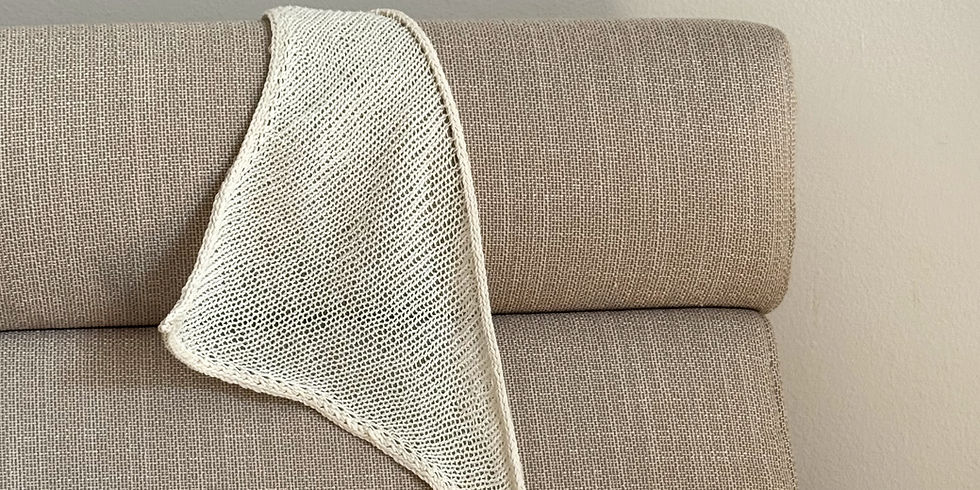How to do the Long-Tail Cast On: A Step-by-Step, Beginner-Friendly Guide
- anouskaiap
- Mar 27
- 4 min read
Updated: Sep 23

The long-tail cast on is one of the most useful techniques every knitter should learn. It’s sturdy yet stretchy, works beautifully for cuffs, hats, and necklines, and creates a clean, polished-looking edge. In this step-by-step tutorial, I’ll show you exactly how to do the long-tail cast on, share my best tips for success, and explain why it’s one of my go-to methods in my own knitting projects.
Why Use the Long-Tail Cast On?
The long-tail is a must-learn cast on method for all new knitters. It'll be your tried-and-true cast-on method for the majority of the projects you knit for many reasons.
Here are a few:
Stretchy yet sturdy: It's ideal for ribbing on sweater cuffs, sock tops, and hats. It's also ideal for the stretch it provides on necklines, cuffs, hats etc.
Smooth, clean edge: Once perfected, it looks neat and professional on garments and accessories.
Easy to pick up into: If you need to come back and pick up stitches to knit a neckband or complete the rest of a sweater yoke, this is by far the easiest to 'read' and pick up and knit stitches into.
Fast and efficient: It will be one of the quickest ways to cast on after you've watched the tutorial and gotten the hang of it.
I use the long-tail cast on constantly in my own designs and it’s my default for basically everything I knit because of all the points I've listed above. If you knit one of my patterns, chances are you’ll see this method recommended in the instructions!
Looking for something that's a bit easier for total beginners and/or not that bothered about a stretchy edge? The Knitted Cast On is what you need.... Check out my how-to blog post!
How to Do the Long-Tail Cast On: Step-by-Step Tutorial (with videos)
Estimate Your Tail Length: A general rule of thumb is about one inch, or 2.5 cm, per stitch, or easier to calculate: roughly three times the width of your finished project. (See the Tips for Success below for some extra advice!)
Make a Slip Knot: Create a slip knot and slide it onto your needle. Place it on your needle ensuring that the tail is towards you and the stretch of yarn with the skein attached is at the 'back'.
Make a diamond shape: Using your left hand, pinch the two threads of yarn between your middle finger and your second to last finger. Putting your thumb and index finger between the two stretches of yarn, spread them out to form a 'diamond' shape.
Scoop Under the front: Twist the diamond, by moving your thumb clockwise away from you so it lines up with your needle. Now, bring the needle over the top of the stretch of yarn between your thumb and middle finger and then loop back under the yarn.
Back Over the Index Yarn: Swing the needle backwards towards the stretch of yarn that is on the index finger. Similarly to the last steep, loop over the yarn with your needle to grab the yarn from your index finger.
Pull Through: Move your thumb to hook that stretch of yarn backwards over the needle. Drop this stretch of yarn off your thumb and pull it to tighten gently.
Repeat: Continue steps 3-5 until you have the desired number of stitches.
To see steps 3 through 6, scroll down to the end of this post for a slower video!
Tips for Success with The Long-Tail Cast On
Use a tail 4x as wide: Yes, I know I said roughly three times up above, but this doesn't account for the stretch of yarn you want to end up with when finishing your cast on. You often use this stretch of yarn to stitch two pieces of knitting together, and even if not it's a helpful reminder of what is the right and what is the wrong side!
Perfect your tension: Hold your thumb and forefinger the same as much as possible to prevent unequal tension across your cast on edge/a messy cast on edge. If you hold the yarn too tight, you risk potentially creating a tight cast on edge that is narrower than the rest of your work though.
So, practice first on a swatch: Before starting your main project, try a few practice cast ons to get comfortable with the rhythm. Once you’ve done it a few times, this becomes one of the fastest cast-on methods.
Keep count: It’s so easy to lose track. Count every 10 stitches to stay on top of it. For example, I count "1,2,3,4,5,6,7,8,9,10...1,2,3,4,5,6,7,8,9,20..." and so on. You could also put a clip in stitch marker every ten stitches – but again this could mess with your tension.
Related Tutorials for Beginners:
If you’re just starting your knitting journey, you need my Beginner’s Guide on How to Start Knitting, it's the perfect place to get started with minimal fuss!
Knitted Cast On Tutorial | An Easy Step-by-Step for Beginners
How to Increase in Knitting: A Must-Read Beginner Knitters Guide
Other Trusted Sources:
If you’re practicing cast ons or looking for alternatives, Purl Soho’s knitting tutorials hub is a wonderful resource for new and experienced knitters alike.























































Comments